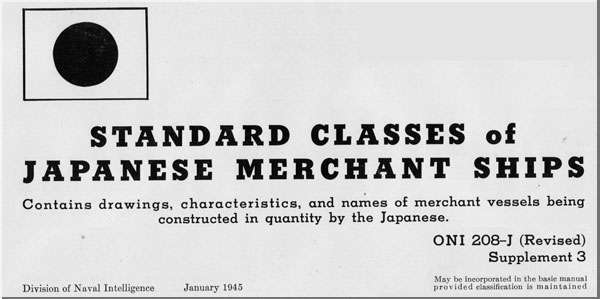
Standard Classes of Japanese Merchant Ships
Contains drawings, characteristics, and names of merchant vessels being
constructed in quantity by the Japanese.
ONI 208-J (Revised)
Supplement 3
| Division of Naval Intelligence January 1945 |
May be incorporated in the basic manual
provided classification is maintained |
Japanese Standard Merchant Ship Construction
In the latter part of 1943 and during 1944, a quantity of new and unknown
Japanese merchant ships have been observed, many of them radically
different in design from the fast, modern vessels of the pre-war era. Sufficient
numbers of the same type of ship have been noted to permit the formation
of definite conclusions as to the amount and character of standardization
accomplished in Japanese wartime merchant ship construction. In addition,
recent captured documents have listed the types adopted as standard and
outlined sufficient characteristics to make possible the identification of
individual classes.
Pre-war Construction
The unusual features of these new vessels can best be illustrated by comparison
with the character of pre-war shipbuilding in Japan. Prior to 1941,
no actual and effective standardization had been accomplished; for, while
shipbuilding was subsidized by the government, design was largely determined
by the shipping concerns or builders. The nature of Japan's merchant
marine activities before the war dictated specifications in ship design which
resulted in a standardization of general types as opposed to the adoption of
an individual design. This has made possible the formulation of the JMST
system of reporting Japanese vessels, a method which recognizes the similarity
in characteristics of vessels within a given tonnage range. Freighter
design on the whole was concentrated in Diesel-powered ships averaging 6,000
gross tons, with streamlined superstructure amidships, cruiser sterns, and
with hulls built for speed. Few engines-aft cargo carriers were constructed
outside of the Amakasu Maru No. 1 class of 1,900 gross tons, of which
about 40 were built before the war. Tanker design tended to 10,000-ton ships
with speeds of 17 knots normal cruising and 20 knots maximum--mostly
fitted with Diesel engines. It is interesting to note that in the 6 years prior
to the outbreak of war approximately 330 ships of over 1,000 tons were built,
involving over 100 different classes; 18 of these classes were composed of 5 or
more ships, but in only 2 were more than 10 built. At variance with this
pre-war record is the tendency in new construction to adopt a few individual
designs and to produce as great a quantity of these as construction facilities
and possible use of mass production methods will allow.
Wartime Design
With her sea lanes enormously extended soon after the outbreak of war, and
with the successful activity of United States submarine patrols becoming
obvious, Japan must have foreseen the inroads which would be made upon her
supply of merchant vessels. Since approximately 2 years are required to
design and initiate construction on standard types of ships, work was apparently
begun on the radically new designs early in 1942; for it is believed that
they did not begin coming off the ways until the early spring of 1944. Between
the fall of 1941 and the start of construction on the new types shipbuilding
is thought to have continued along the lines of the older designs;
for, of the nine standard classes so far identified, two are almost identical
with pre-war design, and two, although never before observed, show no
radical change in design characteristics. It should also be remembered that
between 7 December 1941, and 1 July 1944, approximately 125 ships of non-standard
construction totaling 430,000 gross tons have been built. Construction
of vessels of individual design will undoubtedly continue, to a limited
extent, in the future.
in the preparation of designs for new ships, especially standard designs
from which vessels are to built in quantity, consideration must be given
the requirements of the ship itself, such as speed, cargo capacity, range, etc.,
and the wartime facilities for construction including speed of construction,
availability of various types of engines, facilities for casting or forging parts,
and the like. In the new Japanese designs, cargo capacity and speed of
construction have been given paramount consideration at a considerable
sacrifice in the speed of the ships themselves.
A glance at the drawings included in the discussion of individual types which
follows will show the emphasis which has been placed on engines-aft design.
All but two of the standard classes so far identified are of engines-aft construction.
While this is a logical type for economical operation, it may also
indicate a shortage of facilities for forging the longer propeller shafts needed
in vessels with engines amidship.
Typical of the new hull design is its angularity and its broad beam in relation
to length. The latter is particularly apparent when compared with vessels
of the pre-war period, and again is an indication of the need for large
carrying capacity at a sacrifice in speed. The hull shape suggests the
adoption of flat as opposed to curbed surfaces throughout the vessel, which
increase the rapidity and ease of construction, even by inexperienced builders.
This design can easily be noted in the
photograph which accompanies the
description of Type E being mass-produced at Wakamatsu. In the discussion
of individual types which follows, the word "economy" has been
adopted as descriptive of this shape of hull.
It is interesting to note that in all cases where captured statistical data
can be ascribed with relative certainty to observed design, the term "Modified"
has applied to vessels with "economy" hull shapes. Cruising speeds
specified for the various types are a further indication, since those for the
regular types are consistently 2 to 3 knots higher than those for the Modified
classes. From this it may be assumed that the designs for Types A, B, C,
D, E, TL, TM, and TS are of normal construction. Designs with economy
hulls have been identified for Type A (Modified), D (Modified), E (Modified),
and TM (Modified). Additional "economy" designs have been observed
which closely approximate most specifications for Types B and TS. These
are, in all probability, later modifications which were either in the experimental
stage or not as yet adopted at the time the captured statistics were
issued by the Japanese.
The general use of steam turbine and reciprocating engines instead of Diesel,
which were in common use before the war, is another noteworthy feature
of the standard types. In all probability this indicates a shortage of facilities
for building the more complicated Diesel engine, and also denotes foresight
on the part of the Japanese in that they may in the future be forced to
depend on coal rather than oil for fuel. Among the standard types, Diesels
are being used only in vessels under 1,000 gross tons (Types E and F).
Individual Types
The standard types outlined on the following pages include profile drawings
and photographs where they can be assigned, notes on distinctive features
which will lead to rapid identification, all known statistical information, and,
where possible, names of vessels belonging to the class. Some of the types
have not, as yet, been identified; it is possible that certain of the classes,
such as Type A (Cargo) and TL (Tanker) were nver placed in quantity production.
Several of the profiles have been drawn from vertical photographs
only and should be considered tentative. Note also that ship names listed
for standard types include vessels built up to 1 July 1944, and have been
selected form known construction n the basis of types, tonnage, and year
built. Their assignment, therefore, should not be considered positive. In
addition to the statistical data included under each type, all classes above
1,000 gross tons are believed to carry four depth charges. Profile drawings
have been graded A, B, C, and D to indicate their evaluated accuracy.
This summary has been prepared by the Division of Naval Intelligence.
Extensive use has been made of "Weekly Intelligence" Bulletin No. 12
published by CINCPAC-CINCPOA, and of Shipping Report No. 11 prepared
by the Shipping Center, U.S. Naval Unit, 14th Air Force.
--1--
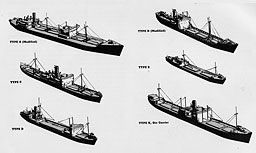
--2--
Standard Classes of Japanese Merchant Ships
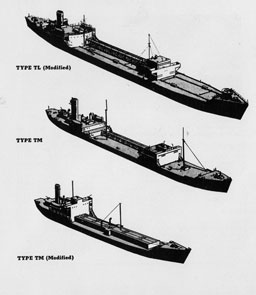 |
Type A (Modified) |
Sugar Baker Love |
| |
Gross tonnage: |
6,670 |
|
| |
Length, o. a.: |
445' |
|
| |
Beam |
64' |
|
| Type C |
Fox Tare Charlie |
| |
Gross tonnage: |
2,700 |
|
| |
Length, o. a.: |
321' |
|
| |
Beam |
45' |
|
| Type D |
Sugar Baker Sugar |
| |
Gross tonnage: |
1,900 |
|
| |
Length, o. a.: |
295' |
|
| |
Beam |
44' |
|
| Type D (Modified) |
Sugar Charlie Love |
| |
Gross tonnage: |
2,300 |
|
| |
Length, o. a.: |
310' |
|
| |
Beam |
49' |
|
| Type E |
Sugar Charlie Sugar |
| |
Gross tonnage: |
830 |
|
| |
Length, o. a.: |
210' |
|
| |
Beam |
36' |
|
| Type K, Ore Carrier |
Fox Tare Charlie |
| |
Gross tonnage: |
5,300 |
|
| |
Length, o. a.: |
410' |
|
| |
Beam |
59' |
|
| Type TL (Modified) |
Sugar Able Love |
| |
Gross tonnage: |
10,000 |
|
| |
Length, o. a.: |
517' |
|
| |
Beam |
67' |
|
| Type TM |
Sugar Able Item |
| |
Gross tonnage: |
5,200 |
|
| |
Length, o. a.: |
410' |
|
| |
Beam |
59' |
|
| Type TM (Modified) |
Sugar Able Sugar |
| |
Gross tonnage: |
2,800 |
|
| |
Length, o. a.: |
325' |
|
| |
Beam |
50' |
|
--3--
TYPE A (Modified)
Sugar Baker Love |
45-MKKMF |
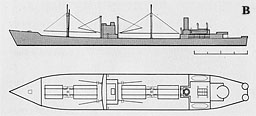
Large engines-aft cargo vessel with pronounced "economy" hull. Note
kingposts against bridge which is located almost amidships, small stack, and
heavy stick masts centered in fore and after wells. One observed variation
has wide cargo hatches extending three-fourths the beam of the ships. Ships
have wide cargo hatches extending three-fourths the beam of the ship. Ships
of this class are under construction at Tokyo and have been observed being
built near Nagasaki. No prefabrication of hull sections is apparent. Jap
Merchant Ship Card No. 8 1007.
TYPE A (Modified)
| Gross tonnage: |
6,670 |
|
Speed, normal cr.: |
10 kts. |
| Disp. tonnage loaded: |
9,720 |
|
Machinery: |
Steam turbine |
| Length, o. a.: |
445' |
|
SHP: |
2,500 (oil) |
| Beam: |
64' |
|
|
2,000 (coal) |
| Draft, loaded: |
25.5' |
|
Cargo booms: |
Twelve 5-ton
One 30-ton |

Type A (Modified)
Approximately 24 Type A and A (Modified) had been built by July 1944.
The following are believed to belong to one of these classes:
| Batopaha Maru |
5953 |
|
Oigawa Maru |
6493 |
| Getsuyo Maru |
6440 |
|
Taiten Maru |
6442 |
| Koyo Maru |
6435 |
|
Tatebu Maru |
6816 |
| Kyokuzan Maru |
6300 |
|
Tatsunan Maru |
6417 |
| Mitsuki Maru |
6440 |
|
Tatsu-ura Maru |
6420 |
| Nichiyo Maru |
6300 |
|
Uyo Maru |
6376 |
| Nichizui Maru |
6584 |
|
Yosan Maru |
6487 |
| Nikkyu Maru |
6529 |
|
Yosho Maru |
6300 |
| Nissho Maru |
6008 |
|
Yowa Maru |
6435 |
| Nisshun Maru |
6380 |
|
Yuzan Maru |
6380 |
TYPE A
| Gross tonnage: |
6,400 |
|
Speed, normal cr.: |
12 kts. |
| Disp. tonnage loaded: |
9,300 |
|
Machinery: |
Reciprocating |
| Length, o. a.: |
445'(?) |
|
IHP: |
3,300 |
| Beam: |
58' |
|
Cargo booms: |
Eight 10-ton |
| Draft, loaded: |
25'5 |
|
|
Eight 15-ton |
| Draft, loaded: |
25'5 |
|
|
Two 25-ton |
NOTE:--Early reports indicated use of steam turbine and Diesel engines in this class.
--4--
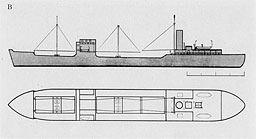
Approximately 30 ships of the class are believed to have been built, including
the following, some of which are possibly of engines admiship construction.
| Anbo Maru |
4,523 |
|
Sankisan Maru |
4,776 |
| Bichu Maru |
4,667 |
|
Shiranesan Maru |
4,739 |
| Bizen Maru |
4,667 |
|
Shiroganesan Maru |
4,739 |
| Chiyo Maru |
4,700 |
|
Shoun Maru |
4,399 |
| Fujishima Maru |
4,930 |
|
Shoyu Maru |
4,408 |
| Kokuyo Maru |
4,667 |
|
Tatebe Maru |
4,519 |
| Konan Maru #1 |
4,558 |
|
Toyu Maru |
4,532 |
| Naruo Maru |
4,823 |
|
Yamamiya Maru |
4,440 |
| Sainei Maru |
4,916 |
|
Yukigawa Maru |
4,502 |
| 45-MKMF |
TYPE B
Sugar Baker Love |

Two new ships, onen with a pronounced angular hull shape, fall with the
probable length range for this class. No other sightings have been observed.
| Gross tonnage: |
4,400 |
|
Speed, normal cr.: |
12 kts. |
| Disp. tonnage loaded: |
7,100 |
|
Machinery: |
Steam turbine |
| Length, o. a.: |
410'
(approx.) |
|
SHP: |
2,400 |
| Beam: |
-- |
|
Cargo booms: |
Six 5-ton |
| Draft, loaded: |
24'3" |
|
|
Four 10-ton |
| |
|
|
|
One 30-ton |
--5--
TYPE A (Modified)
| Gross tonnage: |
|
|
Speed, normal cr.: |
|
| Disp. tonnage loaded: |
|
|
Machinery: |
|
| Length, o. a.: |
|
|
SHP: |
(oil) |
| Beam: |
|
|
|
(coal) |
| Draft, loaded: |
|
|
Cargo booms: |
|
--6--
--7--
--8--
--9--
--1--
--14--






